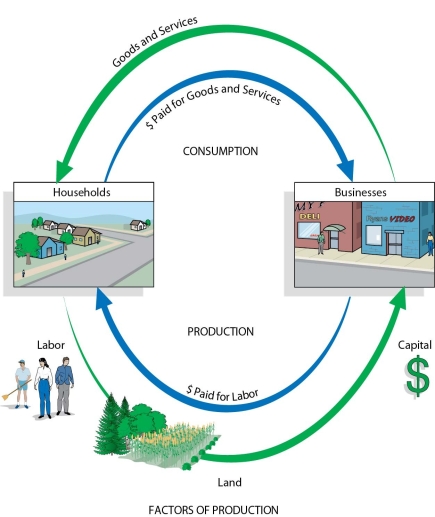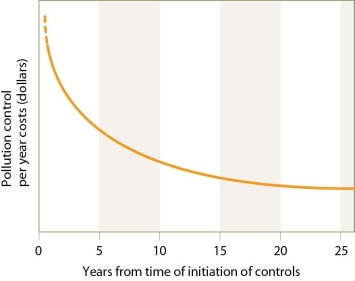A) nonrenewable natural capital.
B) renewable natural capital.
C) intangible capital.
D) produced capital.
Correct Answer

verified
Correct Answer
verified
Multiple Choice
Environmental government policies and regulations are applied at the
A) federal level only.
B) state and federal levels.
C) local,state,and federal levels.
D) local level only.
Correct Answer

verified
Correct Answer
verified
Multiple Choice
 -In the classical view of economic activity in this figure,if the number of households in a region increases,
-In the classical view of economic activity in this figure,if the number of households in a region increases,
A) total household consumption will decrease.
B) the demands for labor will increase.
C) goods and services will decline.
D) the total cost of labor will decline.
Correct Answer

verified
Correct Answer
verified
Multiple Choice
Rising per capita income is associated with
A) decreasing needs for recycling.
B) cleaner air and safer water.
C) increased risks of respiratory disease.
D) increased frequency of water-borne diseases.
Correct Answer

verified
Correct Answer
verified
Multiple Choice
Because of rising environmental and social costs of economic activity,the
A) gap between the GDP and GPI has increased.
B) gap between the GDP and GPI has decreased.
C) GDP has remained stable while the GPI has grown.
D) GDP has declined while the GPI has increased.
Correct Answer

verified
Correct Answer
verified
Multiple Choice
 -As indicated in this figure,the most expensive period of pollution control is from years
-As indicated in this figure,the most expensive period of pollution control is from years
A) 0-5 while the least expensive is in years 20-25.
B) 0-5 while the least expensive is in years 5-10.
C) 20-25 while the least expensive is in years 0-5.
D) 10-15 while the least expensive is in years 15-20.
Correct Answer

verified
Correct Answer
verified
Multiple Choice
Today,environmental regulations in the United States
A) require substantial scientific support and strong political efforts.
B) require only substantial scientific support.
C) are hopeless,with little support remaining and general reversals of many policies and regulations.
D) are simply a matter of politics,with little effort to involve science and scientific data.
Correct Answer

verified
Correct Answer
verified
Multiple Choice
In a free-market society,
A) the needs of the poor are best met by the interests of business.
B) the interests of the poor,labor and business are the same.
C) governments ensure the free flow of goods and services in international trade.
D) the needs of the poor are often not met by business interests but by government programs.
Correct Answer

verified
Correct Answer
verified
Multiple Choice
We would expect that in a community with mounting air and water pollution problems,the
A) economy of the region would decline.
B) unemployment rates would drop.
C) health care would become less important.
D) population would increase.
Correct Answer

verified
Correct Answer
verified
Multiple Choice
From a global sustainability perspective,economic production
A) is the sum of all photosynthesis in the biosphere and the resulting natural products.
B) consists of all of the natural products and natural resources in the world,which are available for harvesting by humans.
C) is the process of converting the natural world to the manufactured world.
D) represents the summed gross national products of all industrialized nations of the world.
Correct Answer

verified
Correct Answer
verified
Multiple Choice
According to 2011 World Bank studies,which of the following is an example of the dominant form of wealth for most countries?
A) minerals and fossil fuels
B) fisheries,forests,and large supplies of water
C) machinery,vehicles,highways,and stock investments
D) the intangible wealth of education and educational systems
Correct Answer

verified
Correct Answer
verified
Multiple Choice
The modern U.S.environmental movement began as a
A) very partisan,divided effort,but now has broad bipartisan support.
B) very partisan effort,which remains partisan and highly contested today.
C) broad bipartisan effort,which remains in effect today.
D) broad bipartisan effort but has fractured into a very contentious partisan debate with intense lobbying.
Correct Answer

verified
Correct Answer
verified
Multiple Choice
What would comprehensive environmental accounting add to the calculation of GDP?
A) the depreciation of natural capital and reductions in ecosystem services
B) the depreciation of human capital and the degeneration of social systems
C) the renewal of natural resources through natural processes
D) income generated from the sale of non-renewable natural resources
Correct Answer

verified
Correct Answer
verified
Multiple Choice
Which part of the government is responsible for passing public-policy laws?
A) executive branch
B) judicial branch
C) legislative branch
D) EPA
Correct Answer

verified
Correct Answer
verified
Multiple Choice
The World Trade Organization
A) mainly regulates the use of global environmental resources.
B) guards human rights and the environmental resources of the world.
C) is widely recognized as the leader of global trade regulation.
D) has steadily lost the power to regulate international trade.
Correct Answer

verified
Correct Answer
verified
Multiple Choice
Environmental public policy
A) diminishes the wealth of a nation.
B) transfers wealth from polluters to pollution controllers and to less polluting companies.
C) is bad for the economy.
D) has significantly increased unemployment in the United States.
Correct Answer

verified
Correct Answer
verified
Multiple Choice
In many countries,the policy life cycle will be in
A) a different stage for different problems,which is unrelated to the stage of economic development of a country.
B) the same stage for different problems,which is unrelated to the stage of economic development of a country.
C) a different stage for different problems,which is related to the stage of economic development of a country.
D) the same stage for different problems,which is related to the stage of economic development of a country.
Correct Answer

verified
Correct Answer
verified
Multiple Choice
Which one of the following would likely result from the imposition of green fees?
A) The price of fossil fuels would decrease.
B) Our economy would move toward sustainability.
C) The price of an item will no longer reflect its total cost.
D) People will increase their use of products that negatively impact the environment.
Correct Answer

verified
Correct Answer
verified
Multiple Choice
Which of the following most accurately indicates the recent changes that have occurred in China? As the Chinese economy has grown,
A) industrial pollution and poverty have increased while literacy and public health have declined.
B) the use of coal and electricity have increased while social mobility and literacy have declined.
C) literacy and public health have improved while industrial pollution and poverty have declined.
D) industrial pollution and literacy have increased while poverty and public health have declined.
Correct Answer

verified
Correct Answer
verified
Multiple Choice
Teaching people to use forests in a sustainable way to produce lawn furniture represents
A) human capital affecting renewable resources,generating produced capital.
B) social capital affecting nonrenewable resources,used in the creation of recycled capital.
C) recycling of nonrenewable resources to generate social capital.
D) knowledge assets impacting nonrenewable resources in the generation of social capital.
Correct Answer

verified
Correct Answer
verified
Showing 21 - 40 of 81
Related Exams